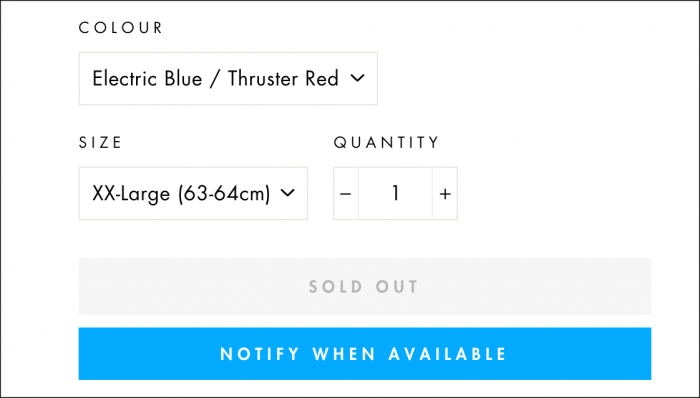By Nino Rosella
Pre-2020 there were two things equally as rare: COVID-19 and the 'Sold Out' badge on online cycling stores. You'll now unfortunately find both in abundance, with the latter following you around the site like your own shadow; plastered across product pages, category pages, and home pages alike.
We're all acutely aware of how the supply chain is currently more stretched than it's ever been. I was talking to one retailer recently who told me that they're unable to get stock from a particular brand until September 2022. That's not a typo. 2022.
Demand is incredibly strong for these products, they tell me. Like lots of stores they're desperately trying to quantify that demand. The analytics are healthy for those particular product pages, likewise inbound customer inquiries. So it makes sense, then, to put in a big order with the distributor and play the waiting game.
I worry that these stores haven't read Rick Vosper's excellent BRAIN article earlier this month, in which he astutely points out that the current demand for products isn't real demand - rather it's perceived demand. He posits that if a customer can't get the product at one store they simply enquire at as many stores as they can. Each of these stores, believing there's strong demand, places an order with the dealer. You now have many stores trying to satisfy the same, single customer.
There will be many among you that are aware of this dynamic, yet won't heed the warning. And I understand that, truly. You're a business owner. An entrepreneur. You've seen an opportunity and you're taking it - armchair pundits be damned.
So then one day, there are 10 of you trying to sell the same product to the exact same customer. You know that you can't take control of the supply, but with a little bit of effort and careful thought you can take some control of the demand through your online store. Here are three tactics to help:
1. Notify your customers when the product is back in stock.
This sounds so obvious, but it's staggering how few stores do this. Most will post a 'Sold Out' notice and leave it at that.
Instead, right next to this notice, you want to insert a method to capture the customer's email address. Below is an example from online retailer Sprocket & Gear.
 You now have a direct line to a customer who has a precise want. The second the stock is back on your shelves you simply let the customers know and include a link to the product in the email. Make it easy for them.
You now have a direct line to a customer who has a precise want. The second the stock is back on your shelves you simply let the customers know and include a link to the product in the email. Make it easy for them.
This sounds labor-intensive, but all the top e-commerce platforms have solutions that automate this whole process.
Pro tip: Don't forget to remove all those 'Sold Out' badges from your products on the category pages otherwise customers won't even bother to click through in the first place.
2. Sell them something similar.
It's very unlikely that a customer will wait until September 2022 for a particular set of handlebars to come back in stock, but you've followed the advice above and now you not only have their email address, but you know precisely which product they're interested in.
So let's say you've collected 50 email addresses for a set of Acme Corp. 10" chrome BMX handlebars. You can now send them a quick email to say that you're not expecting them to come back in stock for a while, but why don't you check out these 10" chrome BMX handlebars by Stark Industries?
Pro tip: Be sure to make the product recommendation hyper-relevant like the example above. Anything less and it's likely the customer will unsubscribe from your emails, and you've lost them forever.
3. Pre-orders.
The best way to make a sale before you have stock is to actually make a sale before you have stock. You can do this by offering pre-orders.
Customers can pay a deposit up-front (refundable or non-refundable), part of the balance now, part later. The whole amount up-front. You can get creative with it.
This is the riskiest of the three tactics presented here, as well as the most labor-intensive. You'll need to have a very good relationship with your distributor to ensure you take accurate, timely delivery of the stock. And be sure to update customers frequently on the status; they've already parted with their hard-earned cash, remember.
Again, all of the top e-commerce platforms have solutions to implement pre-orders on your store.
Pro tip: Set the cash from this sale aside in the same way you do with your tax. You'll be in big trouble if you spend it and have to reimburse your pre-orders for any reason.
As Vosper notes in his aforementioned article, we may well be in for the biggest product oversupply nightmare since the '70s, but I'm hoping with a little care and planning some of you can ride the boom quite nicely.
Editor's note: Nino Rosella is a UK-based advisor to e-commerce cycling firms. He works with them to improve checkout conversions, increase average order value, and reduce duplicate inbound customer inquiries.


